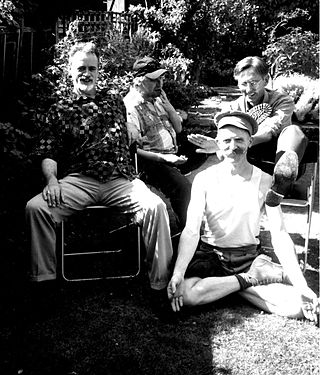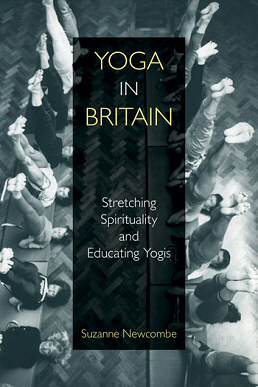Related Research Articles

A new religious movement (NRM), also known as alternative spirituality or a new religion, is a religious or spiritual group that has modern origins and is peripheral to its society's dominant religious culture. NRMs can be novel in origin or they can be part of a wider religion, in which case they are distinct from pre-existing denominations. Some NRMs deal with the challenges which the modernizing world poses to them by embracing individualism, while other NRMs deal with them by embracing tightly knit collective means. Scholars have estimated that NRMs number in the tens of thousands worldwide. Most NRMs only have a few members, some of them have thousands of members, and a few of them have more than a million members.

David Frawley is an American author, astrologer, teacher (acharya) and a proponent of Hindutva.

Stephen A. Kent is a professor in the Department of Sociology at the University of Alberta in Edmonton, Alberta, Canada. He researches new religious movements (NRMs), and has published research on several such groups including the Children of God, the Church of Scientology, and other NRMs operating in Canada.
George D. Chryssides is a British academic and researcher on new religious movements and cults, has taught at several British universities, becoming head of Religious studies at the University of Wolverhampton in 2001. He is an honorary research fellow in contemporary religion at York St John University and the University of Birmingham.
A doomsday cult is a cult that believes in apocalypticism and millenarianism, including both those that predict disaster and those that attempt to destroy the entire universe. Sociologist John Lofland coined the term doomsday cult in his 1966 study of a group of members of the Unification Church of the United States: Doomsday Cult: A Study of Conversion, Proselytization, and Maintenance of Faith. In 1958, Leon Festinger published a study of a group with cataclysmic predictions: When Prophecy Fails: A Social and Psychological Study of a Modern Group that Predicted the Destruction of the World.
The academic study of new religious movements is known as new religions studies (NRS). The study draws from the disciplines of anthropology, psychiatry, history, psychology, sociology, religious studies, and theology. Eileen Barker noted that there are five sources of information on new religious movements (NRMs): the information provided by such groups themselves, that provided by ex-members as well as the friends and relatives of members, organizations that collect information on NRMs, the mainstream media, and academics studying such phenomena.
Catherine Wessinger is an American religion scholar. She is the Rev. H. James Yamauchi, S.J. Professor of the History of Religions at Loyola University New Orleans where she teaches religious studies with a main research focus on millennialism, new religions, women and religion, and religions of India. Wessinger is co-general editor of Nova Religio: The Journal of Alternative and Emergent Religions. She served as a consultant to federal law enforcement during the Montana Freemen standoff and has been cited for her expertise concerning the Branch Davidians and other apocalyptic groups. She is the editor of the Women in Religions series at New York University Press and she is co-editor of the Women in the World's Religions and Spirituality Project, part of the World Religions and Spirituality Project.
Modern yoga is a wide range of yoga practices with differing purposes, encompassing in its various forms yoga philosophy derived from the Vedas, physical postures derived from Hatha yoga, devotional and tantra-based practices, and Hindu nation-building approaches.
Mark Singleton is a scholar and practitioner of yoga. He studied yoga intensively in India, and became a qualified yoga teacher, until returning to England to study divinity and research the origins of modern postural yoga. His doctoral dissertation, which argued that posture-based forms of yoga represent a radical break from haṭha yoga tradition, with different goals, and an unprecedented emphasis on āsanas, was later published in book form as the widely-read Yoga Body.

Selling Yoga : from Counterculture to Pop culture is a 2015 book on the modern practice of yoga as exercise by the scholar of religion, Andrea R. Jain.

A History of Modern Yoga is a 2004 book of social and religious history by the scholar of modern yoga Elizabeth De Michelis. It introduced a typology of modern yoga including modern postural yoga.

Modern yoga as exercise has often been taught by women to classes consisting mainly of women. This continued a tradition of gendered physical activity dating back to the early 20th century, with the Harmonic Gymnastics of Genevieve Stebbins in the US and Mary Bagot Stack in Britain. One of the pioneers of modern yoga, Indra Devi, a pupil of Krishnamacharya, popularised yoga among American women using her celebrity Hollywood clients as a lever.
The World Religions and Spirituality Project publishes academic profiles of new and established religious movements, archive material related to some groups, and articles that provide context for the profiles. It is referenced by scholars, journalists, and human rights groups to provide a scholarly representation of threatened communities.

Positioning Yoga: balancing acts across cultures is a 2005 book of social anthropology by Sarah Strauss about the history of modern yoga as exercise, focusing on the example of Sivananda Yoga.

Yoga in Britain is the practice of yoga, including modern yoga as exercise, in Britain. Yoga, consisting mainly of postures (asanas), arrived in Britain early in the 20th century, though the first classes that contained asanas were described as exercise systems for women rather than yoga. Classes called yoga, again mainly for women, began in the 1960s. Yoga grew further with the help of television programmes and the arrival of major brands including Iyengar Yoga and Ashtanga Vinyasa Yoga.

Yoga in Britain: stretching spirituality and educating Yogis is a 2019 book by Suzanne Newcombe on the history of modern yoga as exercise in Britain in the second half of the 20th century, especially in the period between 1945 and 1980. The book has been warmly received by scholars for its depth of study of the history and sociology of yoga in Britain, and its careful placing of its descriptions in specific contexts of time and place.
Post-lineage yoga, also called non-lineage yoga, is a contemporary form of yoga practised outside any major school or guru's lineage. The term was introduced by the ethnographer and scholar-practitioner Theodora Wildcroft. She stated that with the deaths of the pioneering gurus of modern yoga such as B. K. S. Iyengar and Pattabhi Jois, yoga teachers, especially women, have been reclaiming their practice through their yoga communities, resisting commercialization as well as lineage.
The European Union of Yoga(EUY) is an international non-profit organisation which co-ordinates a network of yoga teachers, training schools and yoga federations. It was founded in 1971, and has since 1973 held an annual congress at Zinal, Switzerland where yoga teachers and practitioners can meet in a multi-lingual, cross-cultural environment and hear from invited Indian yoga teachers.

Gurus of Modern Yoga is an edited 2014 collection of essays on some of the gurus (leaders) of modern yoga by the yoga scholars Mark Singleton and Ellen Goldberg.
Livingstone Fagan – sometimes misspelled as Livingston Fagan – is a British Branch Davidian who survived the Waco siege in 1993. He was born in Jamaica but moved to Nottingham in 1964 with his parents as part of the Windrush generation. He joined the Branch Davidians in 1989 while studying to join the Seventh-day Adventist ministry in the United Kingdom. He moved to Mount Carmel Center with his wife, Evette, and mother, Doris Adina, both of whom would die in the 19 April 1993 fire. He left the Mount Carmel Center before the 19 April fire. He was tried and convicted in the United States of voluntary manslaughter and using a firearm during a crime. He was given a 30-year prison sentence and spent about half of it in various holding facilities in the United States. He was released in July 2007 and deported to the United Kingdom where he currently lives.
References
- 1 2 "Dr Suzanne Newcombe". The Open University. Retrieved 1 November 2022.
- ↑ Newcombe, Suzanne (2007). "Stretching for Health and Well-Being: Yoga and Women in Britain, 1960–1980". Asian Medicine. 3 (1): 37–63. doi:10.1163/157342107X207209.
- ↑ Singleton, Mark (2010). Yoga Body: the origins of modern posture practice. Oxford University Press. p. 17. ISBN 978-0-19-539534-1. OCLC 318191988.
- ↑ "Suzanne Newcombe". The Open University. Retrieved 1 November 2022.
- ↑ "Journal of Yoga Studies". Journal of Yoga Studies. Retrieved 17 March 2019.
- ↑ "Modern Yoga Research" . Retrieved 17 March 2019.
- ↑ "AYURYOG". AYURYOG. Retrieved 1 November 2022.
- ↑ "Suzanne Newcombe". Embodied Philosophy. Retrieved 17 March 2019.
- ↑ "Inform About Us". Inform. Retrieved 1 November 2022.
- ↑ Diane Sawyer, Suzanne Newcombe, Janja Lalich (11 March 2022). The Cult Next Door: The Mystery and Madness of Heaven's Gate. Event occurs at 0:25:00. Retrieved 6 August 2022.
Everyone could be vulnerable if the right message comes at the right, or the very wrong time, in their lives. No one ever joins a cult; no one ever says "oh I'm going to go and give up my critical thinking and sell my soul to someone who's obviously trying to manipulate me."
- ↑ Palmer, Susan J. (2014). "Sarah Harvey and Suzanne Newcombe (eds): Prophecy in the New Millennium: When Prophecies Persist". Review of Religious Research. 57 (1): 165–167. doi:10.1007/s13644-014-0196-8. S2CID 256240560.
- ↑ Crace, Benjamin D. (2014). "Prophecy in the New Millennium: When Prophecies Persist Prophecy in the New Millennium: When Prophecies Persist . Edited by Sarah Harvey and Suzanne Newcombe . Ashgate Publishing Limited , 2013 . 295 pages. $124.95 cloth; $40.46 paper". Nova Religio: The Journal of Alternative and Emergent Religions. 18 (2): 112–113. doi:10.1525/nr.2014.18.2.112.
- ↑ Miller, Christopher Patrick (2019). "Yoga in Britain: Stretching Spirituality and Educating Yogis, by Suzanne New-combe. Sheffield: Equinox, 2019. xiv + 309 pp., £75.00 / $100.00 (hb), £24.95 / $36.00 (pb). ISBN 978-1-78179-659-7 (hb), 978-1-78179-661-0 (pb)". Religions of South Asia. 12 (3): 413–416. doi: 10.1558/rosa.39893 .
- ↑ Crockford, Susannah (2022). "Review Essay: Searching for the Forest among the Trees, A Review of Four Recent Books in Yoga Studies". Nova Religio: The Journal of Alternative and Emergent Religions. 25 (3): 113–118. doi: 10.1525/nr.2022.25.3.113 . hdl: 10871/128697 .
